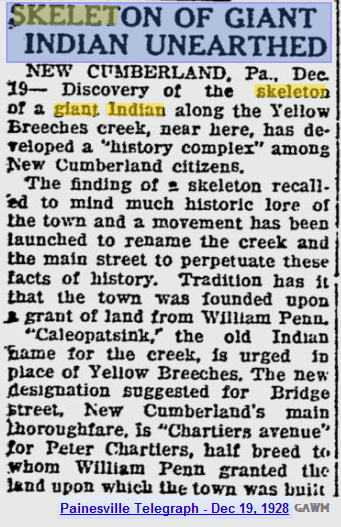New Cumberland Giant in Yellow Breeches
Skeleton of Giant Indian Unearthed

NEW CUMBERLAND, Pa., Dec. 19 – Discovery of the skeleton of a giant Indian along the Yellow Breeches creek, near here, has developed a “history complex” among New Cumberland citizens. The finding of the skeleton recalled to mind much historic lore of the town and a movement has been launched to rename the creek and the main street to perpetuate these facts of history. Tradition has it that the town was founded upon a grant of land from William Penn. “Caleopatsink,” the old Indian name for the creek, is urged in place of Yellow Breeches. The new designation suggested for Bridge Street, New Cumberland’s main thoroughfare, is “Chartiers avenue” for Peter Chartiers, half breed to whom William Penn granted the land upon which the town was built. Painesville Telegraph – Dec 19, 1928.
The discovery of the skeleton of a giant Indian along the Yellow Breeches creek near New Cumberland, Pennsylvania in 1928 has raised a lot of questions about the way archaeological and anthropological artifacts are treated. As a giant researcher, I am deeply disappointed in the loss of such important cultural and historical artifacts. It seems that the way things are done in the scientific community is just looting these cultures for personal gain under the guise of authority.
My main question is where did these bones and artifacts go? Were they studied, preserved, and displayed in a respectful manner? Or were they just taken away for someone’s personal collection or discarded as unimportant? It is important to remember that these artifacts are not just objects to be taken and stored away, but they hold immense cultural and historical value for the people who created them and their descendants.
Furthermore, I also wonder about the ethics and methods of the scientists who took the skeleton and artifacts. Were they given permission to take them? Was the excavation and handling of the artifacts done in a respectful and ethical manner? These are important questions that need to be addressed to ensure that the rights and dignity of these cultures are not violated.
In conclusion, the discovery of the skeleton of a giant Indian along the Yellow Breeches creek near New Cumberland, Pennsylvania raises important questions about the treatment of cultural and historical artifacts. As researchers and scientists, we must strive to uphold ethical standards and ensure that these artifacts are treated with the respect and dignity they deserve.
1. 1928.12.19 – Painseville Telegraph
2. http://chronologiesbookofgiants.blogspot.ca/